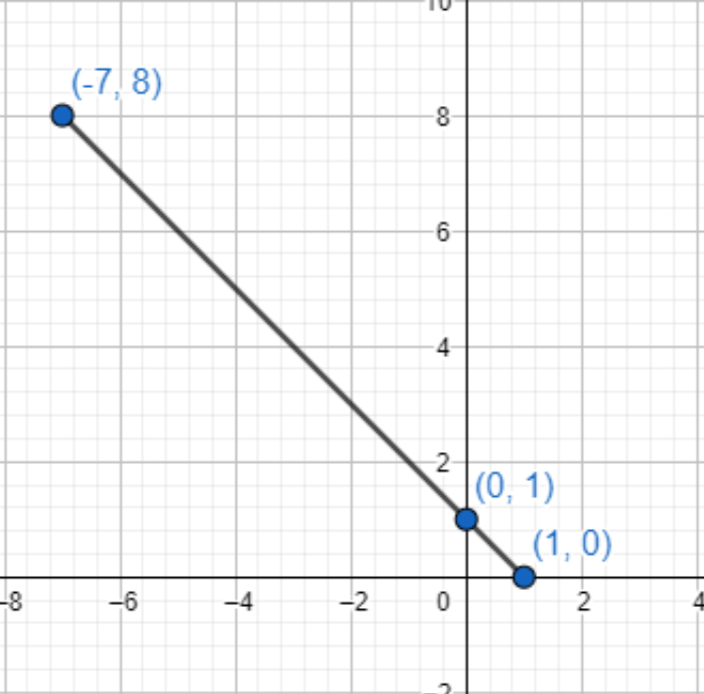
If points (1, 0), (0, 1) and (x, 8) are collinear, then the value of x is
(a) 5
(b) -6
(c) 6
(d) -7
Answer
575.4k+ views
Hint: To solve this question we will use the fact that three points are said to be collinear if the area of triangle formed using these three points is zero. Area of triangle, \[\Delta =\dfrac{1}{2}\left| \begin{matrix}
1 & 1 & 1 \\
{{x}_{1}} & {{x}_{2}} & {{x}_{3}} \\
{{y}_{1}} & {{y}_{2}} & {{y}_{3}} \\
\end{matrix} \right|\]. This way we can easily determine the value of x. To get started, first assume the given points from the question as \[\left( {{x}_{1}},{{y}_{1}} \right)=\left( 1,0 \right)\], \[\left( {{x}_{2}},{{y}_{2}} \right)=\left( 0,1 \right)\], \[\left( {{x}_{3}},{{y}_{3}} \right)=\left( x,8 \right)\] . Now, substitute these properly in the determinant and equate it to 0 to find the value of x.
Complete step-by-step solution:
Given that point (1, 0), (0, 1) and (x, 8) are collinear.
We know the fact that when three points are collinear, it means they lie on the same line. Such a set of points cannot form a triangle where all three points must lie on different lines. So, the area of the triangle formed using these three points will be zero.
Area of triangle, \[\Delta =\dfrac{1}{2}\left| \begin{matrix}
1 & 1 & 1 \\
{{x}_{1}} & {{x}_{2}} & {{x}_{3}} \\
{{y}_{1}} & {{y}_{2}} & {{y}_{3}} \\
\end{matrix} \right|\], where, \[\left( {{x}_{1}},{{y}_{1}} \right)=\left( 1,0 \right)\], \[\left( {{x}_{2}},{{y}_{2}} \right)=\left( 0,1 \right)\], \[\left( {{x}_{3}},{{y}_{3}} \right)=\left( x,8 \right)\].
Given that points are collinear \[\Rightarrow \Delta =0\].
Substituting the value in \[\Delta \] we get;
\[\Rightarrow \Delta =\dfrac{1}{2}\left| \begin{matrix}
1 & 1 & 1 \\
1 & 0 & x \\
0 & 1 & 8 \\
\end{matrix} \right|=0\]
Opening the determinant along first column we get;
\[\begin{align}
& \Rightarrow \dfrac{1}{2}\left| \begin{matrix}
1 & 1 & 1 \\
1 & 0 & x \\
0 & 1 & 8 \\
\end{matrix} \right|=0 \\
& \Rightarrow \dfrac{1}{2}\left[ 1\left( -x \right)-1\left( 8-0 \right)+1\left( 1-0 \right) \right]=0 \\
& \Rightarrow \dfrac{1}{2}\left( -x-7 \right)=0 \\
& \Rightarrow -x=7 \\
& \Rightarrow x=-7 \\
\end{align}\]
Hence the value of x for which the points (1, 0), (0, 1), and (x, 8) are collinear is -7, which is an option (d).
We can also plot the points and understand that they are collinear as shown below,

Note: Another way to solve this question is opening the determinant directly without using the area of triangle in determinant form.
We can directly use, \[\dfrac{1}{2}\left[ {{x}_{1}}\left( {{y}_{2}}-{{y}_{3}} \right)+{{x}_{2}}\left( {{y}_{3}}-{{y}_{1}} \right)+{{x}_{3}}\left( {{y}_{1}}-{{y}_{2}} \right) \right]\] = 0, and substitute value of \[\left( {{x}_{1}},{{y}_{1}} \right),\left( {{x}_{2}},{{y}_{2}} \right)\] and \[\left( {{x}_{3}},{{y}_{3}} \right)\] directly to get the answer. The answer anyway would be the same.
1 & 1 & 1 \\
{{x}_{1}} & {{x}_{2}} & {{x}_{3}} \\
{{y}_{1}} & {{y}_{2}} & {{y}_{3}} \\
\end{matrix} \right|\]. This way we can easily determine the value of x. To get started, first assume the given points from the question as \[\left( {{x}_{1}},{{y}_{1}} \right)=\left( 1,0 \right)\], \[\left( {{x}_{2}},{{y}_{2}} \right)=\left( 0,1 \right)\], \[\left( {{x}_{3}},{{y}_{3}} \right)=\left( x,8 \right)\] . Now, substitute these properly in the determinant and equate it to 0 to find the value of x.
Complete step-by-step solution:
Given that point (1, 0), (0, 1) and (x, 8) are collinear.
We know the fact that when three points are collinear, it means they lie on the same line. Such a set of points cannot form a triangle where all three points must lie on different lines. So, the area of the triangle formed using these three points will be zero.
Area of triangle, \[\Delta =\dfrac{1}{2}\left| \begin{matrix}
1 & 1 & 1 \\
{{x}_{1}} & {{x}_{2}} & {{x}_{3}} \\
{{y}_{1}} & {{y}_{2}} & {{y}_{3}} \\
\end{matrix} \right|\], where, \[\left( {{x}_{1}},{{y}_{1}} \right)=\left( 1,0 \right)\], \[\left( {{x}_{2}},{{y}_{2}} \right)=\left( 0,1 \right)\], \[\left( {{x}_{3}},{{y}_{3}} \right)=\left( x,8 \right)\].
Given that points are collinear \[\Rightarrow \Delta =0\].
Substituting the value in \[\Delta \] we get;
\[\Rightarrow \Delta =\dfrac{1}{2}\left| \begin{matrix}
1 & 1 & 1 \\
1 & 0 & x \\
0 & 1 & 8 \\
\end{matrix} \right|=0\]
Opening the determinant along first column we get;
\[\begin{align}
& \Rightarrow \dfrac{1}{2}\left| \begin{matrix}
1 & 1 & 1 \\
1 & 0 & x \\
0 & 1 & 8 \\
\end{matrix} \right|=0 \\
& \Rightarrow \dfrac{1}{2}\left[ 1\left( -x \right)-1\left( 8-0 \right)+1\left( 1-0 \right) \right]=0 \\
& \Rightarrow \dfrac{1}{2}\left( -x-7 \right)=0 \\
& \Rightarrow -x=7 \\
& \Rightarrow x=-7 \\
\end{align}\]
Hence the value of x for which the points (1, 0), (0, 1), and (x, 8) are collinear is -7, which is an option (d).
We can also plot the points and understand that they are collinear as shown below,

Note: Another way to solve this question is opening the determinant directly without using the area of triangle in determinant form.
We can directly use, \[\dfrac{1}{2}\left[ {{x}_{1}}\left( {{y}_{2}}-{{y}_{3}} \right)+{{x}_{2}}\left( {{y}_{3}}-{{y}_{1}} \right)+{{x}_{3}}\left( {{y}_{1}}-{{y}_{2}} \right) \right]\] = 0, and substitute value of \[\left( {{x}_{1}},{{y}_{1}} \right),\left( {{x}_{2}},{{y}_{2}} \right)\] and \[\left( {{x}_{3}},{{y}_{3}} \right)\] directly to get the answer. The answer anyway would be the same.
Recently Updated Pages
Master Class 12 Business Studies: Engaging Questions & Answers for Success

Master Class 12 Economics: Engaging Questions & Answers for Success

Master Class 12 English: Engaging Questions & Answers for Success

Master Class 12 Maths: Engaging Questions & Answers for Success

Master Class 12 Social Science: Engaging Questions & Answers for Success

Master Class 12 Chemistry: Engaging Questions & Answers for Success

Trending doubts
What is meant by exothermic and endothermic reactions class 11 chemistry CBSE

Which animal has three hearts class 11 biology CBSE

10 examples of friction in our daily life

One Metric ton is equal to kg A 10000 B 1000 C 100 class 11 physics CBSE

1 Quintal is equal to a 110 kg b 10 kg c 100kg d 1000 class 11 physics CBSE

Difference Between Prokaryotic Cells and Eukaryotic Cells




